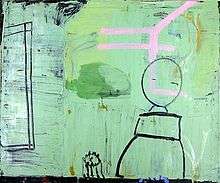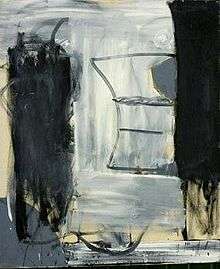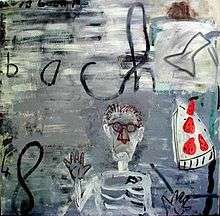Roy Oxlade
Roy Oxlade (13 January 1929 – 15 February 2014) was an English painter, writer on art, and an art educator.[1][2]
Roy Oxlade | |
|---|---|
| Born | 13 January 1929 Tottenham, England |
| Died | 15 February 2014 (aged 85) |
| Occupation | English painter |
Biography

Roy Oxlade was born in Tottenham, England to Emily and William Oxlade. He was educated at the Bromley School of Art and Goldsmiths in London, and was a student of David Bomberg for two years at the Borough Polytechnic.[3] He received his PhD from the Royal College of Art. His PhD thesis was on David Bomberg and titled, Bomberg and the Borough: An Approach to Drawing.[3]
While studying at Goldsmiths, Oxlade met the painter, Rose Wylie, a fellow student, and they married in 1957.[3]
Roy Oxlade: Work from the 80s & 90s (2018), the first solo exhibition of Oxlade's work since his death, received critical acclaim and coverage in numerous publications including Frieze[4], ArtLyst[5] and Mousse.[6]
In 2019, it was announced that Oxlade would be the subject of the inaugural exhibition at Hastings Contemporary, Hastings, United Kingdom.[7]
Paintings
Oxlade is quoted in a 2013 exhibition review:
"Painting to me is like a room of the imagination. It’s up to me what I do with it. I choose its size and its materials – usually canvas and oil paint. At the beginning its relationships don’t amount to much – it’s a rectangle in a jumble of art history I relate to. There would not be much fun in leaving the room empty, a passive – one colour field – a blank canvas. And entirely abstract forms place too many restrictions on dialogue. So I have put in some other stuff, some characters, some actors – tables, pots, colours, easels, lamps, scribbles, figures and faces to interact with each other. I adjust the temperature, open the windows, shut the windows, throw things out, change the lighting."[2]
In a written dialogue with the painter Marcus Reichert in 2003, Oxlade said:
"Like poetry, painting’s got its own language of metaphor: I think of van Gogh’s The Night Café, a bowl of flowers by Rousseau, many Matisses: the aubergines still life in Grenoble, Music, the Red Dessert. Matisse sometimes managed to achieve wonderfully direct drawing within his painting like he does with the box of pencils in the Red Studio. Aren’t these paintings modernism? A rich vein, you could call it metaphorical modernism; it makes the rest of painting, ancient and modern, so much framed tedium. They’re a hundred years old, but that’s not so long in the scale of things. Do they mark the end of what’s possible? Spengler? Gombrich? We don’t need them to remind us; it’s obvious that ‘we’ve lost faith in our own culture’. The rush to abstraction was a diversion, the dismantling too fast; the dialogue dried up – in abstraction there were no metaphors to make. Philip Guston made a defiant counter-attack but just now the language of painting seems to be foreign. But when cat-walk art has finally imploded perhaps there can be a fresh and essentially evaluative look at metaphorical modernism. That could initiate a continuation of representational painting."

In his essay of 2009, There's An Iceberg Up Ahead, Oxlade wrote:
"Desperate measures for desperate times; what is the role of art at a time of global emergency? Art’s first response must be to release itself from its old myths. For centuries art has been so closely tied to the prevailing ideology that any need to adjust our way of life in a way that will make a difference to the planet’s current problems will mean that art too must rethink its position fundamentally. Art History is the ‘official’ art history and as such it stands monumentally as the custodian of the iconography of our mercantile past, itself currently on trial. The store rooms of our art galleries and museums bulge with artefacts illustrating the evolution not only of realist art but also the story it tells of unworthy heroes and their inglorious lives. Certainly, the history of art is sprinkled with outstanding exceptions, where art escapes from social conformity, and the great value and significance of those exceptions must not be overlooked. Yet, if these are indeed desperate times should we not be considering how much of it should go? Michelangelo, Leonardo, Rembrandt, Vermeer, Titian, Velazquez – even the greatest are all deeply implicated in a history of narcissism and literalism. Such art, because of an apparent brilliance which goes unquestioned, is especially dangerous when it provides the cultural underpinning of a society now in need of different support."
Personal
Oxlade and Wylie's three children are Luke-John, Elizabeth, and Henrietta.[3]
Bibliography
- Oxlade (1977). David Bomberg 1890-1957. Patronage and Teaching 1913-1945; The Approach to Painting. London: Royal College of Art. ISBN 0902490230.
- Oxlade (2010). Art and Instinct: Selected Writings of Roy Oxlade. Edited by Marcus Reichert. London: Ziggurat Books. ISBN 9780956657909.
Essays

- Oxlade (2008). "'Good' Draughtsmanship or Real Drawing". Art without Art: Selected Writing from the World of Blunt Edge. Edited by Marcus Reichert. London: Ziggurat Books. pp. 16–20. ISBN 9780954665661.
- Oxlade (2008). "Vitamin D: For Drawing". Art without Art: Selected Writing from the World of Blunt Edge. Edited by Marcus Reichert. London: Ziggurat Books. pp. 29–31. ISBN 9780954665661.
- Oxlade (2008). "David Bomberg: The Climate Is Changing". Art without Art: Selected Writing from the World of Blunt Edge. Edited by Marcus Reichert. London: Ziggurat Books. pp. 38–45. ISBN 9780954665661.
- Oxlade (2008). "A Fear of Transcendence". Art without Art: Selected Writing from the World of Blunt Edge. Edited by Marcus Reichert. London: Ziggurat Books. pp. 49–55. ISBN 9780954665661.
- Oxlade (2008). "A Primitive Reformation". Art without Art: Selected Writing from the World of Blunt Edge. Edited by Marcus Reichert. London: Ziggurat Books. pp. 61–65. ISBN 9780954665661.
- Oxlade (2008). "Guston & Eliot". Art without Art: Selected Writing from the World of Blunt Edge. Edited by Marcus Reichert. London: Ziggurat Books. pp. 89–91. ISBN 9780954665661.
- Oxlade (2008). "Trust Me, I'm a Curator". Art without Art: Selected Writing from the World of Blunt Edge. Edited by Marcus Reichert. London: Ziggurat Books. pp. 104–107. ISBN 9780954665661.
References
- Reg Gadney (28 February 2014). "Roy Oxlade obituary". The Guardian. Retrieved 11 March 2014.CS1 maint: ref=harv (link)
- "Roy Oxlade. It's what you see". Wall Street International Magazine. 12 June 2013. Retrieved 11 March 2014.CS1 maint: ref=harv (link) Review of the 2013 exhibition at the Art Space Gallery, London, with photographs of seven paintings.
- Reg Gadney 2014
- "Roy Oxlade's Subtle Strain of Humour". Frieze.com. Retrieved 28 March 2019.
- "Roy Oxlade: Painting A Sense Of The Absurd - Edward Lucie-Smith". Artlyst.com. Retrieved 28 March 2019.
- "Mousse 64 •". moussemagazine.it. Retrieved 28 March 2019.
- "Jerwood Gallery to relaunch as Hastings Contemporary after losing British art collection". Theartnewspaper.com. Retrieved 28 March 2019.
General references
- Michael Gaca (2002). "Exhibition List". Belgrave St Ives Gallery. Archived from the original on 13 March 2014. Retrieved 11 March 2014.
External links
- Roy Oxlade (April 2001). "'Good' Draughtsmanship or Real Drawing". Blunt Edge. Retrieved 11 March 2014.
- "It's what you see::Paintings and Drawings". Art Space Gallery | Michael Richardson Contemporary Art (Exhibition catalog). Retrieved 11 March 2014.
- 1 painting by or after Roy Oxlade at the Art UK site. Retrieved 11 March 2014.